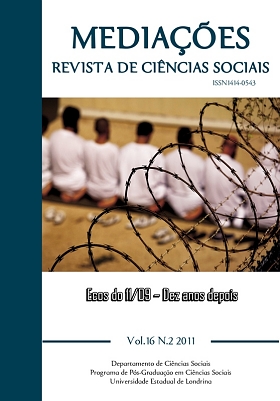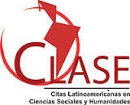Far-right associativisms in the post 9/11 era
DOI:
https://doi.org/10.5433/2176-6665.2011v16n2p123Keywords:
Far-right, Intolerance, September 11, White supremacy, XenophobiaAbstract
A more precise mapping of the actions of «hate groups» as well as its repression, were included in the strategic treatment of acts of terrorism and security threat in the United States in recent decades. The same trend has occurred in European countries due to the growth of extreme right and xenophobia. Two chronological milestones are key to understanding significant changes and a new approach of U.S. authorities concerning the action of «hate groups», whether supremacists or the militia: the attacks of September 11, 2001, and the election of Obama in 2008. This article seeks to contribute to the understanding of both the change in the concept of «terrorism», and the identification of the effects of this change reflected in new guidelines for hate crimes as well as the classification and mapping of the actions of extremist right-wing American groups.Downloads
References
BELLO, Marisol. White supremacists target middle America. USA Today, 21 oct. 2008.
BERLET, Chip; LYONS, Matthew N. Right-wing Populism in America: too close for comfort. London: Guilford, 2000.
CASTELLS, Manuel. The crisis of democracy, global governance, and the rise of the global civil society. In: INTERNATIONAL SEMINAR FOR A GLOBAL GOVERNANCE, 2004, São Paulo. Anais... São Paulo: IFH- Instituto Fernando Henrique Cardoso, 2004.
CHEN, Stephanie. Growing hate groups blame Obama, economy. 2009. DIAMOND, Sara. Roads to dominion: right-wing movements and political power in the United States. London: Guilford, 1995.
FBI. Intelligence Assessment. A threat assessment for domestic terrorism.Washington: Federal Bureau of Investigation, Department of Justice, 2007.
FBI.Domestic extremism lexicon. 29 mar. 2009. Disponível em: http://www.fas.org/irp/eprint/lexicon.pdf. Acesso em: 1 set. 2011.
FBI.Range and racism: skinhead violence on the far righ. 2008a. Disponível em http://info.publicintelligence.net/Skinhead_Rage_and_Racism.pdf. Acesso em: 1 set. 2011.
FBI.White Supremacist recruitment of military personnel since 9/11. 7 july 2008b. Disponível em: http://cryptome.org/spy-whites.pdf. Acesso em: 1 set. 2011.
HAINSWORTH, Paul (ed.). The extreme right in Europe and the USA. New York: St. Martin’s Press, 1992.
HOFSTADTER, Richard. The paranoid style in American politics and other essays. Cambridge: Harvard Universiy Press, 1996.
IGNAZI, P.; PERRINEAU, P. L’Extreme Droite en Europe: Marginalité du Neofascisme et Dynamique de l’Extrême Droite Post-industrielle. In: GRUNBERG, Gérard (org.). Le vote des quinze: les élections Européennes du 13 juin 1999. Paris: Presses de Sciences Po, 2000. p. 223-242.
IGNAZI, Piero. Extreme right parties in western Europe. Oxford: Oxford University Press, 2003.
IGNAZI, Piero.The intellectual basis of right-wing anti-partytism. European Journal of Political Research, v. 29, n. 3, p. 279-296, 1996.
KALDOR, Mary; GLASIUS, Marlies. Global civil society 2002. Oxford: Oxford University Press, 2002.
KITSCHELT, Herbet; McGANN, Anthony. The radical right in western Europe: a comparative analysis. Michigan: University of Michigan Press, 1995.
MEDEIROS, Sabrina E. Extremismo de direita nos Estados Unidos através da Internet. 2007.
MUDE, Cas. Populism radical right parties in Europe. Cambridge: Cambridge University Press, 2007.
MUDE, Cas. The war of words defining the extreme right party family. West European Politics, v. 19, n. 2, p. 225-248, 1996.
NORRIS, Pippa. Radical right: voters and parties in the electoral market. Cambridge: Cambridge University Press, 2005.
POGUNTKE, Thomas; SCARROW, Susan. The politics of anti-party sentiment: introduction. European Journal of Political Research, v. 29, p. 257-262, 1996.
PUTNAM, Robert. Bowling alone: the collapse and revival of american community. New York: Simon and Schuster, 2000.
RYDGREN, Jens. Explaining the emergence of radical right-wing populism: the case of Denmark. West European Politics, v. 27, n. 3, p. 474-502, 2004.
RYDGREN, Jens. The sociology of the radical right. Annual Review of Sociology, v. 33, p. 241-262, 2007.
SOUTHERN POVERTY LAW CENTER – SPLC. Disponível em: http://www.splcenter.org/. Acesso em: 1 set. 2011.
START. National Consortium For the Study of Terrorism and Responses to Terrorism. Background Report: terrorist attacks in New York city. 2010. Disponível em: http://www.start.umd.edu/start/announcements/announcement.asp?id=185. Acesso em: 1 set. 2011.
STORMFRONT. Disponível em: http://www.stormfront.org/forum/. Acesso em: 8 dez. 2011.
TAGGART, Paul. The new populism and the new politics: new protest parties in Sweden in a comparative perspective. Basingstoke: Macmillan, 1996.
TAGGART, Paul. A Touchstone of Dissent: Euroscepticism in Contemporary Western European Party Systems. European Journal of Political Research, v. 33, p. 363- 388, 1998.
TE-SAT. Eu terrorism situation and trend report. EUROPOL. European Policy Office. 2011.
WALZER, Michael. On toleration. New Haven: Yale University Press, 1997.
Downloads
Published
How to Cite
Issue
Section
License
Copyright on articles published in Mediações belongs to the author(s): in the case of partial or entire republication of the original publication, we ask author(s) to indicate the original publication in the periodical.
Mediações uses the Creative Commons Attribution 4.0 International license, which allows Open Access, enabling any user to read, download, copy and disseminate its content so long as adequately referenced.
The opinions expressed by the author(s) are their sole responsibility.
































